
Market research is a critical component of any successful business strategy, providing valuable insights that can help guide your decisions and shape your future.
Whether you’re launching a new product, entering a new market, or refining your current offerings, understanding your audience and industry is key.
In this guide, we’ll walk you through the essentials of market research and how our expert team can help you unlock actionable data that drives growth.
What is Market Research?
Market research is the process of gathering information about your target market, customers, and competitors to make better business decisions. It helps you understand what people want, what they think about your products or services, and what trends are shaping your industry. By using surveys, interviews, and other methods, market research provides valuable insights that help businesses improve products, target the right audience, and stay ahead of the competition.
Primary vs. Secondary Market Research
Primary and secondary market research are two fundamental categories in the field of market research, each serving distinct purposes when on the hunt for data-driven insights.
Primary research involves the direct gathering of information from original sources. While, secondary research involves the analysis of existing data and information that has been previously collected by other sources.
We outline the key differences below.
| Factor | Primary Market Research | Secondary Market Research |
|---|---|---|
| Definition | Data collected directly from original sources or subjects. | Analysis of pre-existing data collected by others. |
| Methods | Surveys, interviews, focus groups, observations. | Industry reports, government publications, academic papers. |
| Purpose | To gather specific, fresh insights for a particular study. | To gain broad, contextual insights or historical trends. |
| Cost | Generally more expensive due to direct data collection. | Usually free or low cost since data is already available. |
| Timeframe | More time-consuming due to data collection and analysis. | Faster, as the data is already available. |
| Level of Customization | Highly tailored to the research objective. | Broader and less specific, used for general context. |
| Insights | Provides specific, detailed insights related to the target audience. | Provides context, trends, and background information. |
Types of Market Research
Next, it’s important to establish the two categories of market research, qualitative and quantitative, to gain a better understanding of the various primary marketing research methodologies.
Qualitative Market Research
Qualitative research is an exploratory type of research, designed to gain a deeper insight into the underlying reasons, opinions, and motivations of a consumer.
Qualitative research allows your target audience to answer questions like:
- How did this commercial make you feel?
- What do you like most about X product?
- Why are you more likely to buy X product over Y?
Quantitative Market Research
Quantitative research is a statistical type of research, used to quantify and answer objectives by generating numerical data.
For example, an organization can conduct an online survey to collect statistical data on its brand, through the opinion of its customers.
Quantitative surveys can measure metrics such as:
- Awareness
- Perception
- Customer satisfaction
- Likelihood to recommend
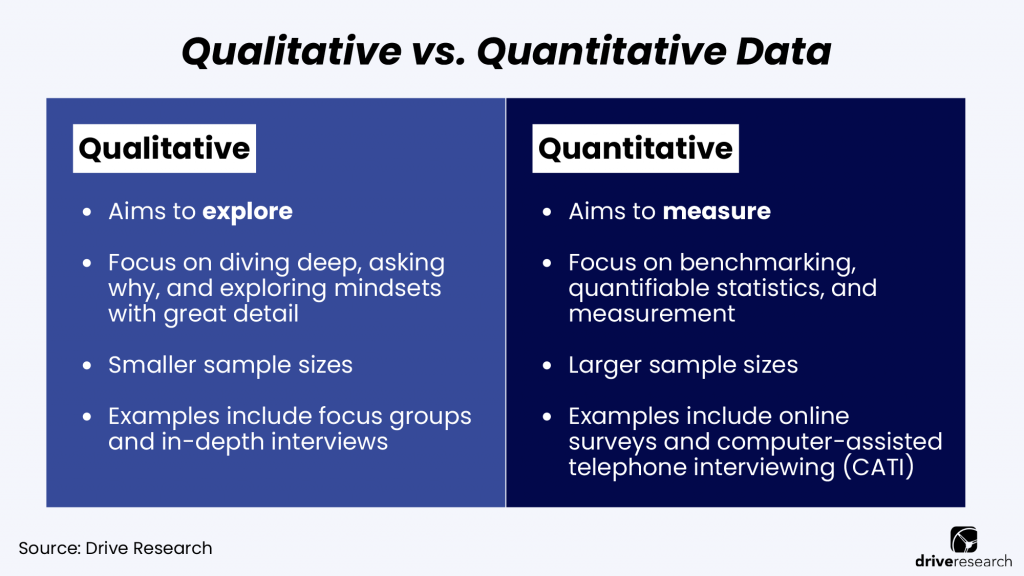
Market Research Methods (Pros & Cons)
There is no one “best” market research methodology as the most appropriate method depends on the specific research question and the target demographic.
Different research methods have different strengths and limitations.
Below, we cover the most common types of market research and their pros and cons to help determine which methodology is best for your unique needs.
For a short synopsis, I recommend watching the video from our market research company below.
1. Online Surveys
Online surveys are a form of quantitative research aimed at gaining feedback and insight on a specific objective. Web surveys are designed, programmed, and administered – you guessed it – online.
With the rise of technology, most surveys online are equipped to be taken on smartphones and tablets as well.
Pros of surveys online ✅
Low cost
A major benefit of conducting surveys online is reaching a mass audience at low costs and in little time.
Traditional survey methods like phone or mail often require a large budget to achieve successful and accurate results.
Quick insights
An organization can obtain quick feedback from customers with a web-based questionnaire at little to no cost.
When working with an online survey agency, organizations can create, send, and receive results all in a matter of days.
Here is the process Drive Research follows when conducting online surveys for our clients.
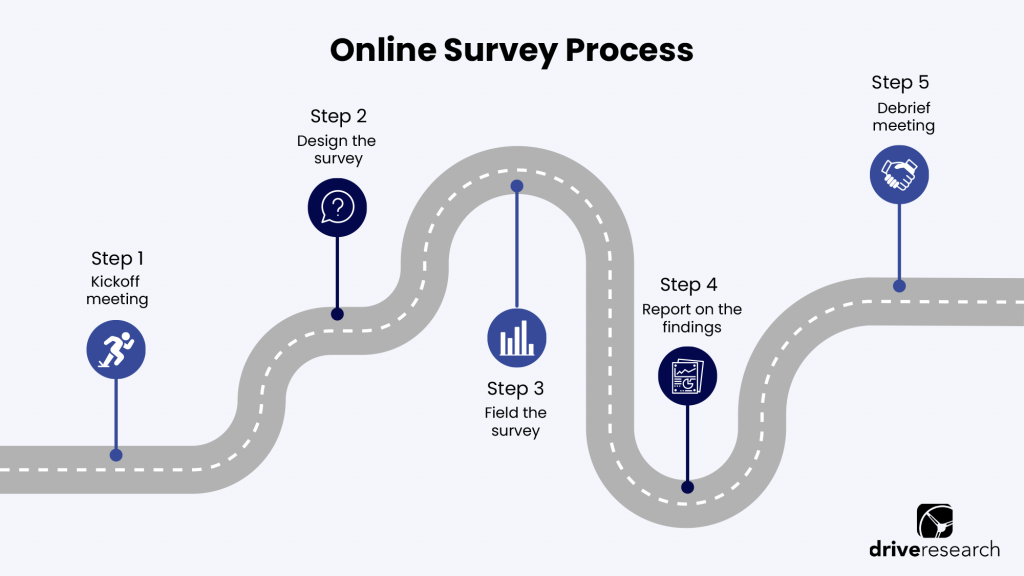
Reduces response bias
Respondents may be more opt to provide honest feedback with online surveys as well.
Being that there is no moderator or interviewer, survey participants feel more inclined to offer up raw emotions and opinions on a company, products, or services.
Cons of online surveys ❌
Technical errors
As much as technology has progressed through the years, it’s nowhere near perfect. Technical mishaps happen every day and online surveys are no exception.
A poor user experience associated with technical problems such as a slow page load time, or worse timing out, can subsequently affect the online survey data.
Unfortunately, these online glitches aren’t always apparent at first sight. Significant errors within online platforms often don’t show up until the survey results are complete.
Less detailed feedback
Oftentimes, our market research company is asked: how many questions should I ask in my survey?
It’s also a good rule of thumb to keep online surveys short and sweet. 15-20 questions is the sweet spot.
That’s because, unless informed otherwise, participants are less likely to stay fully engaged in a survey that takes more than 10 minutes to complete.
Therefore, with little real estate, it’s difficult to obtain detailed answers to key business questions.
2. Phone Surveys
Phone surveys began as a core market research methodology decades ago and still prove to be at the forefront of market research methodologies.
This type of market research centers around collecting deeper feedback from two-way active communication between the interviewer and respondents.
Pros of phone surveys ✅
Two-way communication forum
The advantage of conducting a phone survey lies in the high quality of data it provides.
As opposed to other market research methodologies, phone surveys allow for an active and personable conversation between the interviewer and the participant.
Gather more in-depth insights
In comparison to online surveys, interviewers can receive additional feedback from respondents.
In other words, you are at the mercy of how much or how little participants are going to answer a question online – whereas phone surveys allow interviewers to ask respondents to explain their answers.
Respondents are more likely to answer phone survey questions in greater detail because it takes less time to voice your opinion than it would to type or write.
Survey participants from anywhere
Phone surveys are also at no mercy of the locale.
Especially with the move from landlines to mobile phones, phone survey companies can connect with respondents whether they are traveling, on their lunch break, taking a walk outside, etc.
Cons of phone surveys ❌
More costly
Where phone surveys may provide high-quality and immediate results, it is not as cost-effective or time-efficient as other market research methodologies.
Phone survey companies must collect a long list of participants to speak to, to then spend hours having detailed conversations or leaving voicemails.
Must conduct the research at specific times of day
Another factor driving the collapse of phone surveys is that the study has time constraints to work around. This means phone survey participants will likely only be available to speak outside of business hours.
Other factors such as taking care of children, going to the gym, and running errands can limit the available time respondents have to complete a phone survey.
Recommended Reading: Online Surveys vs. Phone Surveys – Which is Better for Your Business?
3. Customer Surveys
Customer satisfaction surveys measure the level of satisfaction a customer has with a brand.
This is critical to the success of a brand – how will they know how to cater to customers without asking them?
With the data gathered from these surveys, brands can implement…
- Improved marketing strategies
- Better customer service techniques
- Personalized shopping experience
And this last one is super important, as 68% of consumers prefer a personalized shopping experience.
Below, we’ll cover some of the top benefits of running customer surveys, along with potential drawbacks.
Pros of customer satisfaction surveys ✅
Insight into customer preferences and behaviors
Think of these surveys as a tool to directly tap into your audience.
Here are some types of insights you can gather from customer surveys:
- How satisfied or dissatisfied customers are with your products or services
- Identify emerging trends and changing customer preferences in the market
- Demographic information such as age, gender, location, occupation, etc. to tailor marketing efforts accordingly
- Insights into the decision-making process of customers, including factors that influence their buying decisions
Identifying areas for improvement
We like to use this scenario: there may be something about your brand that customers dislike, making them less likely to buy from you.
With customer surveys, brands will be able to identify this type of issue straight from the customer. With that information, brands can improve their strategies.
Measuring customer satisfaction and loyalty
Surveys that measure customer satisfaction metrics such as Net Promoter Score (NPS) offer valuable data about how happy your customers are.
The key here is to track this data for continued improvement.
As we always say, market research isn’t a one-and-done deal, especially when you’re dealing with surveys. Measuring customer opinion through surveys should be an ongoing strategy, as this allows brands to observe current trends and adjust accordingly.
By continued measurement, brands will always be improving their strategies. This leads to increased customer retention, loyalty, and word-of-mouth referrals.
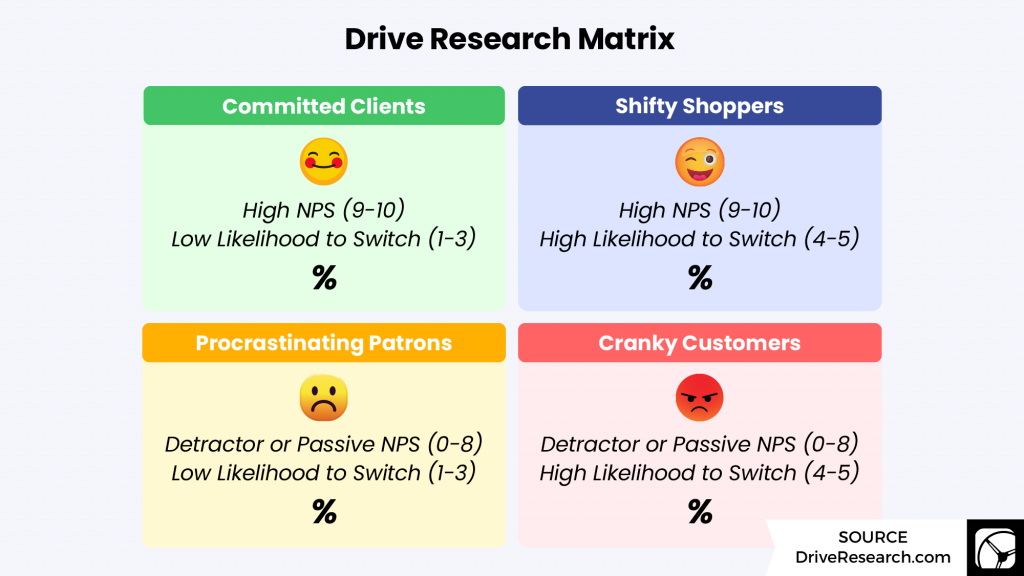
Cons of customer surveys ❌
Survey fatigue
This drawback is more related to how the surveys are distributed.
Put yourself in this position. If a store you’ve shopped at is continuously sending you links to take a survey, you’re probably going to rush through the survey or ignore it.
This is why it’s so important to time your surveys correctly. Sending too many will likely annoy your customers (and maybe even push them away).
Remember, as a brand, you want your customers to know you care, but don’t be pushy about it!
The limited scope of feedback
Depending on the depth of data you want to uncover, surveys may not be the best option.
One of the benefits of surveys is that they offer structured questions for better-defined responses.
However, this can backfire and end up limiting you depending on your needs. If you’re looking for more detailed insights, surveys may not be the answer.
Instead, methodologies such as customer focus groups or in-depth interviews will be a better fit as they offer more in-depth feedback.
But more on that in a minute!
4. Mail Surveys
Emails, text messages, voicemails. Our inboxes are flooded with them. What about physical mail?
What once was labeled as an antiquated form of communication, mail surveys are back with a vengeance.
Mail surveys are a quantitative marketing research data collection method in which respondents complete questionnaires on paper and return them via postal mail.
Mail survey pros ✅
Mail surveys may seem like an archaic methodology, but they do offer some intriguing benefits.
Best for industries with PII restrictions
Depending on the industry, say banks and credit union market research, businesses cannot reach their audience through online outlets due to organizational restrictions.
Mail surveys offer a personalized, credible solution to this problem.
Good response rates
Direct mail surveys also earn a good response rate.
Where most think direct mailers receive a 1-2% response rate, a mail survey company like Drive Research has seen an average response rate of 10-15%.
When potential participants actually open and hold the mail survey in their hands, many will opt to reply.
An email or online survey is much easier to ignore.
Mail survey cons ❌
Before you run to the post office, it should be noted that the average data quality and time invested in mail surveys deter non-restricted industries from choosing this type of market research methodology.
Timely and costly
The process of conducting mail surveys can be long and strenuous.
Only after you create and format the survey for mail, return for postage, fill and send the direct mail piece, and finally wait for responses to return are you able to start entering data.
Produces less detailed feedback
When choosing to participate in mail surveys, respondents are less likely to provide detailed answers as they would on the phone or online because it takes less time to talk or type a response, than it is to write one.
5. Intercept Surveys
Intercept surveys are a form of quantitative research focused on capturing “in-the-moment” feedback from respondents.
This type of market research is commonly used after people attend an event or visit an establishment to collect perception information. Although, data can also be collected before or during a participant’s experience.
The feedback received from intercept surveys is usually collected via tablets or paper and pencil interviewing techniques.
If utilizing tablets or other electronic devices, our intercept survey company recommends using a platform with offline functionality.
Do not rely on Wi-Fi offered by large venues such as concerts or sporting events, because you will be fighting to connect to the internet with thousands of people.
Intercept survey example
Compared to other types of market research methods, intercept surveys allow for immediate, top-of-mind feedback from your customers.
For example, to test the success of a digital billboard at a New York Mets game, an intercept survey company representing Pepsi can conduct market research outside of Citi Field.
After the game, interviewers will approach fans as they are leaving the stadium to ask questions like:
- What billboard(s) did you remember seeing inside Citi Field?
- What type of food or beverage did you consume during the game?
- Are you more likely to choose Pepsi or Coca-Cola? What is the reason for this choice?
Drive Research conducted intercept surveys at 5 college football stadiums across the country.
Learn about our objectives, approach, and outcomes of the stadium intercepts.
Intercept survey advantages ✅
By approaching an audience remotely after the experience you are trying to test, the context is top of mind.
Interviewers in turn receive a fresh, candid response. Often times online or email surveys aren’t sent until days/weeks/months after an event has taken place.
This space in time can allow for a misguided representation of what actually happened.
Recommended Reading: Key Benefits of Offline Surveys
Intercept survey disadvantages ❌
With this specific example, Pepsi would need permission from Citi Field to conduct this survey. Without permission, there is no survey and they’re back to the market research drawing board.
Another drawback to intercept surveys is lower participation rates compared to other market research methodologies. If people are leaving a venue, they are ready to go home or to their next destination.
They likely are not prepared or willing to stop and take an unsolicited survey. Rewards or trinkets are important to offer here.
6. Concept Testing
Ad concept testing can be considered both quantitative and qualitative market research depending on the approach that is used.
For example, brands can utilize online surveys and/or focus groups to measure consumer feedback regarding a set of advertisements.
The objective of ad concept testing is to compare various advertising or marketing messages to see which of the tested ads resonate most with the brand’s target audience.
For an in-depth overview, I recommend reading The Ultimate Guide to Ad Concept Testing Surveys.
Advantages to ad concept testing ✅
Rely on data-driven marketing strategies
Ad concept testing is an excellent way to develop and refine marketing campaigns before launching them to the public.
Think of it like this. Buying a house is a huge investment. For this reason, many homebuyers tour and assess the property to limit any unwarranted costs after purchasing it.
The same analogy can be used for data-driven marketing strategies.
Spend marketing dollars more wisely
An ad concept testing survey assures that you are putting your money into the right message and design before investing too much money.
Better yet, this type of market research can help brands increase their return on investment than not conducting any research at all.
Disadvantages to ad concept testing surveys ❌
While I’d say the pros of ad concept testing far outweigh the negatives, I’ll play devil’s advocate for just a moment.
Just like any market research study, if done incorrectly concept testing can produce misleading and inaccurate data.
As a result, brands end up making near-useless decisions as they drain more time and resources into a marketing campaign.
7. PR or Content Surveys
PR surveys gather public opinion about a certain topic and are a useful type of market research to invest in.
A quantitative form of research, PR surveys are a fantastic way for businesses to garner publicity as they gather statistical data that can be used by news outlets for various stories.
These surveys are also referred to as:
- Content surveys
- Public opinion polls
- PR polling
When working with a PR survey company, brands can administer the questionnaire to a specific demographic group or the general population. From there, the standard online survey process is followed.
Advantages of PR surveys ✅
There are plenty of benefits to conducting public relations surveys.
We’re stating the obvious here, but journalists are always hungry for the latest findings on any topic. Using data from a PR survey in a press release is a great way to attract attention from journalists.
Grow brand awareness
PR surveys can draw potential customers and clients to your brand. Say a figure from your custom PR survey catches the eye of a journalist and it ends up in a popular publication.
Not only will you have your statistics published, but this exposure has the chance to draw several people to your business.
Generate more backlinks and improve website visibility
All this activity will positively affect your brand’s website, too.
Your data being referenced on news publication websites has the chance to:
- Generate backlinks
- Increase your domain authority
- Boost website traffic
For example, Drive Research often conducts public relations surveys as a link-building strategy. Our research has been featured on USA Today, CNBC, Yahoo News, and more sites. As a result, we’ve seen thousands more pageviews to our website and an improved domain authority
Be seen as an industry thought leader
When a brand is linked to accurate data, it automatically is seen as a trusted source by the public. People will begin to associate your organization with having reliable information about a specific topic.
Again–this could lead to increased customer activity and loyalty.
Disadvantages of PR surveys ❌
One disadvantage of PR surveys is simply choosing a topic to conduct a study on.
In a way, this could be seen as a “good” disadvantage–having too many topics is better than having too few.
But to get public attention, you’ll need to choose the perfect topic. This takes time and will require teamwork.
Conducting a PR survey does not automatically guarantee you will see media attention from the results. It is important to find a topic that is unique and headline-worthy.
8. Mystery Shopping
Mystery shopping is a type of market research using professionally trained shoppers to assess an experience in a natural storefront or retail environment.
Both qualitative and quantitative, mystery shopping is a perfect project to test all areas of customer service.
Mystery shopping examples
Two common best practices of mystery shopping are recruiting actual customers or hiring a market research team to uncover key business findings.
Say you are the owner of an Italian restaurant and you want to test how friendly the wait staff is. You can hire actual customers to eat at your restaurant by providing them with an evaluation form to track their experience.
Another example of mystery shopping could be testing employees’ knowledge of your product or service line.
A bank or financial institution could choose to hire a mystery shopping research company to call and speak with a loan officer as if they were a prospective customer looking to buy a house.
In this example, a bank could evaluate their employer based on:
- Knowledge of home and mortgage loan services
- Ability to communicate and identify a solution
- Speaking in a friendly and professional manner
- Following through on a promise to follow up with the “prospective customer”
Mystery shopping advantages ✅
Compared to survey questions that skew positive answers, mystery shopping can provide informal opinions and feedback on a variety of in-store elements such as cleanliness, product placement displays, and store layout.
The value and results found from partnering with a mystery shopping company, allow organizations to reevaluate their business from the outside looking in.
This type of market research clearly identifies training needs and sales opportunities to ensure a positive customer relationship on the front line.
Mystery shopping disadvantages ❌
When considering mystery shopping as a market research study you must also take into account, that a participant’s experience in a store only represents a single interaction with the staff and store location.
A busy day, short staff, or various other customer service elements can cause a poor experience. This single instance may not truly represent a typical customer visit.
9. Focus Groups
Focus groups are a form of qualitative research that involves an open dialogue between 4 to 12 participants and a trained moderator to guide the discussion.
A focus group company will often recommend holding two separate groups to answer the same questions.
If only moderating one focus group, you may have 3 axe grinders steering the discussion in one way, which will lead to inaccurate feedback.
Having a second focus group will act as a gut check to verify the findings from the first group.
Focus group participants often answer questions such as:
- How would you buy X product?
- What would you change about X product?
- What did you like about X product? What didn’t you like about X product?
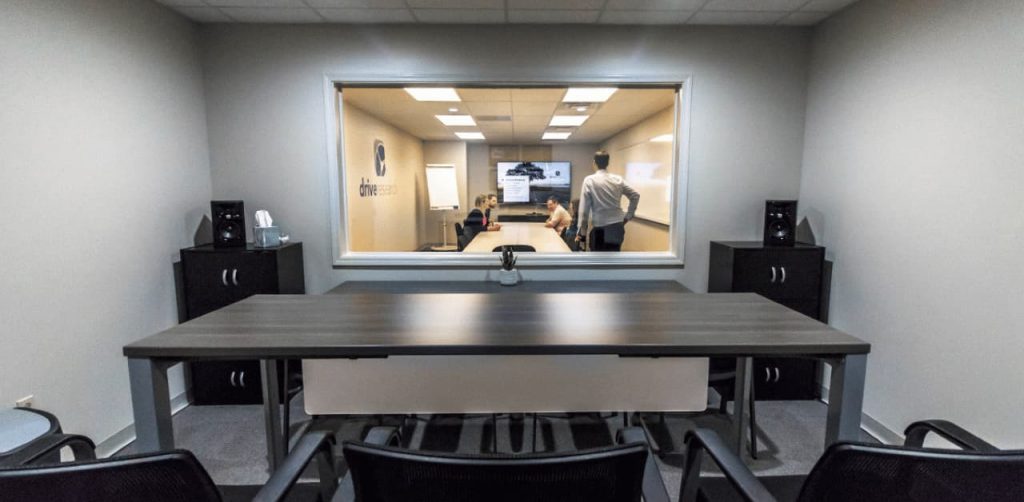
Focus group discussion advantages ✅
A focus group allows a group of targeted individuals to talk through their opinions, reactions, and feelings surrounding a product, commercial, advertisement, etc.
This targeted group of individuals generally offers insight into how the larger market would react to these same marketing tactics.
These group discussions are best held at a focus group facility equipped with a one-way mirror.
In doing so, you can have an inside look while research is conducted – a quality not a lot of other research methodologies can provide.
Focus group discussion disadvantages ❌
With higher quality research and data, comes a higher price tag. Focus group fees depend on a variety of factors such as time of day, length of the focus group, the demographic of participants, amount of travel, etc.
Oftentimes businesses choose to conduct online focus groups to reduce the cost of market research. Remote focus groups decrease costs associated with qualitative recruitment, travel, facility rental, and more.
You must also be wary of focus group moderator biases. The moderator running the session may subconsciously ask questions in a way that influences the participants of a focus group.
These biased interactions can skew the data of focus group results.
Recommended Reading: Ultimate Guide to Online Focus Groups
10. In-Depth Interviews
In-depth interviews (IDIs) are a qualitative market research method involving a direct, one-on-one engagement with individual participants.
IDIs are not bound to a single location as they can be conducted in person, on the phone, or via webchat.
However, if the study requires visuals or videos to share, then an in-person or web conference interview is best.
In-depth interview example
In recent years, there has been an increase in B2B organizations utilizing in-depth interviews to speak with subject-matter experts who have a career in a specific industry.
For example, Cisco may consider using IDI research to speak with CEOs or IT purchasing managers to understand their buying process for technology equipment.
In-depth interviews can reveal information such as:
- The decision-making process for selecting a product
- Any stakeholders involved in the B2B buying decision
- What factors are considered before making the purchase
- Whether the company is happy with the product they chose
In-depth interview advantages ✅
As opposed to quick phone surveys, IDIs are reserved for deeper conversations lasting anywhere from thirty to ninety minutes.
IDIs also include more than just a survey representative but many roles of a market research company such as a moderator, a senior research analyst, and a project manager.
For this reason, it is important to have a scheduled meeting time for the in-depth interview company and participant to speak.
In-depth interviews disadvantages ❌
The downside to this type of market research is the time commitment and large budget necessary for conducting in-depth interviews.
Because participants tend to be high-level executives, some type of incentive is usually required to encourage participation.
With this in mind, there is a tedious vetting process that is now required to make sure potential respondents aren’t cheating the system to make a quick buck.
Once all qualified participants are chosen and the IDIs are scheduled, in-depth interview companies will then transcribe, analyze, and report back their findings.
Recommended Reading: Higher Rewards Can Equal Lower Market Research Costs – Here’s Why
11. Feasibility Studies
A feasibility study is a type of market research that predicts the success or failure of a new business venture.
This could be a new product, service, concept, or location. It utilizes both primary and secondary market research to analyze the outcome of an idea or potential concept.
Drive Research often conducts feasibility studies for:
- New product development
- New service launches
- New business concepts
- New business locations or an expansion to a new market
Many businesses find it important to work with a feasibility studies company and invest a little money now, before wasting money on a failed business venture down the road.
Advantages of feasibility studies ✅
Before investing too much money and time into a new product, service, or site location, a feasibility study relies on predictive analytics to inform better business decisions.
This not only gives business owners peace of mind but is a great study to present to potential investors as well.
Feasibility studies can also provide great insight to help encourage the success of a new concept such as:
- Who is the target audience?
- How likely are they to purchase this product or service?
- What are their main sources of awareness?
- Who are your competitors?
When introducing a new concept or location to the market it is best to make data-driven decisions. This is not the time to rely on assumptions or what you think will work.
Disadvantages of feasibility studies ❌
Feasibility studies are a more expensive type of market research. Because this methodology requires several components such as secondary research, competitor analysis, and pricing analysis it takes time to accomplish each task.
The more project management time a project takes, the more expensive the project becomes. As a result, new businesses do not have the budget needed for this methodology.
Benefits of Market Research
Informed Decision Making
There is perhaps no greater advantage to conducting market research. It provides businesses with valuable data that helps them make more informed decisions. By understanding customer preferences, market trends, and competitor strategies, businesses can make choices that align with market demands, minimizing risks and increasing the chances of success.
Improved Product Development
Through market research, businesses gain insights into what their customers truly want and need. This feedback allows companies to develop products or services that meet these demands more effectively, ensuring that their offerings are well-received in the marketplace.
Targeted Marketing Strategies
With market research, companies can identify the specific segments of their audience who are most likely to purchase their products or services. This enables businesses to craft more targeted marketing campaigns that resonate with the right people, ultimately improving conversion rates and return on investment. For example, here is a customer segment we created based on a survey f 1,000 grocery shoppers across the country.
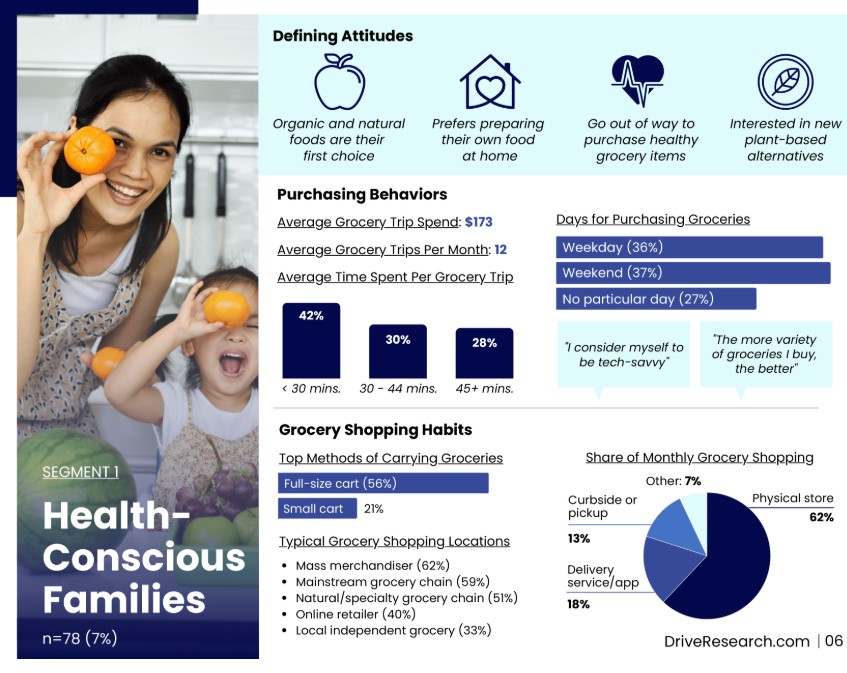
Competitive Advantage
By conducting market research, businesses can stay ahead of the competition. Researching competitors, market trends, and consumer behaviors helps identify new opportunities, uncover threats, and refine strategies, giving businesses a competitive edge in a crowded marketplace.
Customer Satisfaction and Retention
Market research provides insights into customer satisfaction levels, helping businesses identify areas where they can improve their products, services, or customer experience. By addressing customer concerns and exceeding expectations, businesses can improve customer loyalty and retention.
Risk Reduction
Lastly, market research helps businesses anticipate potential challenges and issues before they arise. By understanding market conditions and customer expectations, businesses can adjust their strategies accordingly, reducing the likelihood of costly mistakes or product failures.
Drawbacks to Market Research
Time-Consuming Process
Market research, especially primary research, can be a time-intensive process. Gathering data through surveys, focus groups, or interviews, followed by analysis, often takes significant time. Businesses may have to wait weeks or even months to obtain actionable insights, especially for more in-depth research.
However, when working with the right research partner, they can help streamline these efforts through efficient planning, expert facilitation, and tools designed to accelerate data collection and analysis. This allows businesses to access critical insights more quickly, saving valuable time.
Costly for Small Businesses
For smaller companies, conducting comprehensive market research can be expensive. Hiring experts, running surveys, and gathering data often require substantial financial resources, which may be out of reach for businesses with limited budgets.
When partnering with an experienced market research firm, smaller businesses can benefit from more flexible, cost-effective research options. A full-service provider can tailor research methods to meet specific needs and budgets, ensuring that even smaller-scale projects deliver valuable insights without overextending financial resources.
Misinterpretation of Results
The risk of misinterpreting market research data is real, especially if the analysis is done without a clear understanding of the context or research objectives. Poor analysis can lead to incorrect conclusions, which can negatively affect business decisions.
Though, when collaborating with a trusted market research partner, they bring the necessary expertise to interpret data accurately and provide actionable recommendations.
Their experience ensures that the insights are correctly analyzed, contextualized, and aligned with business goals, helping businesses make informed and confident decisions.
Market Research Example
Let’s say a new coffee shop is planning to open in a busy urban area and wants to ensure that their concept will resonate with the local community. To gather insights, they choose a market research firm to conduct both primary research.
The conducts primary research through two methods:
- Surveys: They distribute an online survey to local residents to understand their coffee preferences, how often they visit coffee shops, and what factors influence their decision-making (e.g., price, ambiance, location).
- Focus Groups: The firm organizes small focus group sessions with a diverse set of participants from the target area to gather qualitative feedback on the proposed coffee shop concept. They ask questions about product offerings, brand names, and store atmosphere.
Analysis and Recommendations
After gathering data, the firm analyzes the responses.
They find that:
- A large portion of the target audience prefers specialty coffee drinks over traditional options.
- Convenience (such as proximity to work or school) is a critical factor for choosing a coffee shop.
- Many local residents value a cozy ambiance with free Wi-Fi for working or studying.
Based on these insights, the coffee shop owner is advised to focus on offering a variety of specialty drinks, providing a comfortable and inviting atmosphere, and choosing a location near popular office buildings and schools.
Through this market research, the coffee shop is able to make data-driven decisions that improve their chances of success, reducing the risks associated with launching a new business.
Contact Our Full-Service Market Research Company
Drive Research is a national market research company. Our team has the knowledge and tools to design a robust market research study for a variety of organizations across the country.
Interested in learning more about our market research services? Reach out below.



